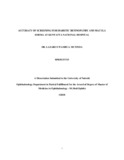| dc.contributor.author | Mutinda, Lazarus W | |
| dc.date.accessioned | 2019-01-15T06:46:02Z | |
| dc.date.available | 2019-01-15T06:46:02Z | |
| dc.date.issued | 2018 | |
| dc.identifier.uri | http://hdl.handle.net/11295/104676 | |
| dc.description.abstract | Background: Low income countries in Asia and Africa have both the highest prevalence of diabetes mellitus (DM) and expected rise in disease burden. Many patients with diabetes are unaware of their diagnosis and may not receive treatment in a timely fashion. These diabetic retinopathy screening programs (DRSP) where regular eye examinations are done,can minimize the risk of visual loss. In Kenya, most of the patients with diabetes are screened for diabetic retinopathy (DR) with indirect fundoscopy and only few facilities are using the fundus camera. While dilated fundoscopy has been found to be an effective method of screening, it requires to be performed by an experienced person. Fundus camera has been preferred because it does not need a highly experienced person and more people can also be screened per day compared to dilated fundoscopy. Current fundus cameras used for screening are non-mydriatic. However its accuracy has not been validated in our setup.
Objective: The general objective was to assess the accuracy of screening for diabetic retinopathy in diabetic patients attending the medical outpatient clinic at Kenyatta National Hospital (KNH). The specific objectives were: to compare grading of DR using fundus photographs by the technician (screener) and Early Treatment Diabetic Retinopathy Study (ETDRS) clinical grading by the ophthalmologist and to compare diagnosis of macula edema using fundus photographs and optical coherence tomography (OCT).
Materials and methods: This was a cross sectional hospital based study. Patients were recruited in the MOPC.56 patients attending medical outpatient clinic (MOPC) were randomly selected then screened. First consent was taken then a questionnaire administered then fundus photographs were captured in all the patients. After retinal photography, patients were dilated and fundoscopy was done on all patients regardless of their DR status. A questionnaire was administered to all patients with DR who gave consent. The eyes of all patients screened for DR were scanned using OCT. The primary outcome was presence or absence of DR or macula edema. | en_US |
| dc.language.iso | en | en_US |
| dc.publisher | UoN | en_US |
| dc.rights | Attribution-NonCommercial-NoDerivs 3.0 United States | * |
| dc.rights.uri | http://creativecommons.org/licenses/by-nc-nd/3.0/us/ | * |
| dc.subject | creening For Diabetic Retinopathy And Macula Edema | en_US |
| dc.title | Accuracy Of Screening For Diabetic Retinopathy And Macula Edema At Kenyatta National Hospital | en_US |
| dc.type | Thesis | en_US |
| dc.description.department | a
Department of Psychiatry, University of Nairobi, ; bDepartment of Mental Health, School of Medicine,
Moi University, Eldoret, Kenya | |



